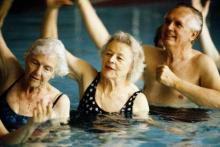WASHINGTON – For the first time, a randomized study has demonstrated that vigorous physical exercise not only improves cognition, but moves Alzheimer’s disease biomarkers in the right direction.
Six months after subjects with mild cognitive impairment (MCI) began aerobic exercise, scores on a composite measure of cognition rose significantly. Not only that, hypometabolic brain regions associated with Alzheimer’s symptoms were reperfused. And phosphorylated tau – a marker of neuronal injury – fell significantly in cerebrospinal fluid (CSF), Laura Baker, Ph.D., said at the Alzheimer’s Association International Conference 2015.
The finding of reduced tau is especially intriguing, said Dr. Baker of Wake Forest University, Winston-Salem, N.C. The biggest improvements occurred in subjects older than 70 years, who were carrying a double hit of both MCI- and age-related tau.
“I hope that we are moving toward being able to demonstrate that regular, moderate aerobic exercise can attenuate the effects of both aging and Alzheimer’s. This is a potential intervention that combats two diseases – if we regard aging as a disease process.”
Aerobic exercise is easy to institute, inexpensive to continue, and confers numerous physical and mental benefits, Dr. Baker said.
“Like other lifestyle interventions, exercise targets multiple, health-restoring biological processes. It’s not just one molecule affecting one part of our chemistry, but multiple targets. These kinds of interventions with diversified target portfolios may be our most potent means to prevent and slow Alzheimer’s.”
She and her colleagues conducted a 6-month exercise trial with 71 sedentary adults who had both MCI and prediabetes (hemoglobin A1c of 5.7%-6.4%). The subjects, aged 55-89 years, were randomized to either a control program of thrice-weekly stretching, or to an exercise program of thrice-weekly aerobic exercise for 45-60 minutes. Most subjects used a treadmill, but other forms of exercise were also allowed, including stationary bike and approved group classes.
The intervention group aimed to maintain an exertion level of 70%-80% of their maximum heart rate, while the control group exercised at below 35% of it. Both interventions were carried out under the supervision of a study researcher. This is an important point, Dr. Baker noted, because it means that both groups were getting the benefit of leaving their house several times a week and experiencing social interactions in classes at the gym.
At baseline and 6 months, everyone completed cognitive testing (verbal recall, tests of executive function); a 400-meter timed walking test; glucose tolerance test; body fat assessment; and blood and CSF collection. A total of 40 also underwent structural and functional brain MRI. All results were controlled for age and education.
For the analysis, Dr. Baker stratified the group by those younger and older than 70 years.
There were no reductions in CSF tau in either age group in the stretching cohort. However, in the exercise cohort, both age groups experienced significant declines in CSF tau. Tau is released when neurons are damaged; reductions in tau suggest a slowing of that damage. The older group’s tau levels declined by 10 pg/mL – especially impressive when considering that their baseline levels were elevated not only from their cognitive disorder, but from normal aging.
“In fact, the greatest drops in tau occurred among the folks who were starting with the highest levels,” Dr. Baker said.
She found a trend – albeit nonsignificant – for a positive change in CSF amyloid-beta-42 among the intervention group. “In the stretching group, we expected to see continuation of disease, and this was reflected in the CSF amyloid levels, which increased over 6 months. In the aerobic group, this increase appeared to be attenuated.”
Whole brain blood flow also improved significantly in the exercise group and was driven by increased flow in regions particularly associated with aging and Alzheimer’s: the superior frontal cortex, posterior cingulate, and cingulate gyrus.
“In all three regions blood flow was increased bilaterally, and these increases were similar. This was encouraging and suggests that changes related to aging and Alzheimer’s benefited. Typically, the signature profile of aging is reduced flow in the superior frontal region, and the profile for Alzheimer’s is reduced flow in the posterior cingulate and cingulate gyrus. These are exactly the regions that were boosted by exercise.”
The cognitive measure was a compilation of several tests of executive function. “Independent of age and APOE4 [apolipoprotein E epsilon-4] status, we saw significantly improved performance.”
Dr. Baker said that she is eager to follow-up with her cohort and find out not only how many have independently continued to exercise, but to retest them and see if the effects were transient or imparted some lasting benefit. She also plans to initiate an 18-month, phase III trial of the two interventions at 15 sites throughout the United States.


